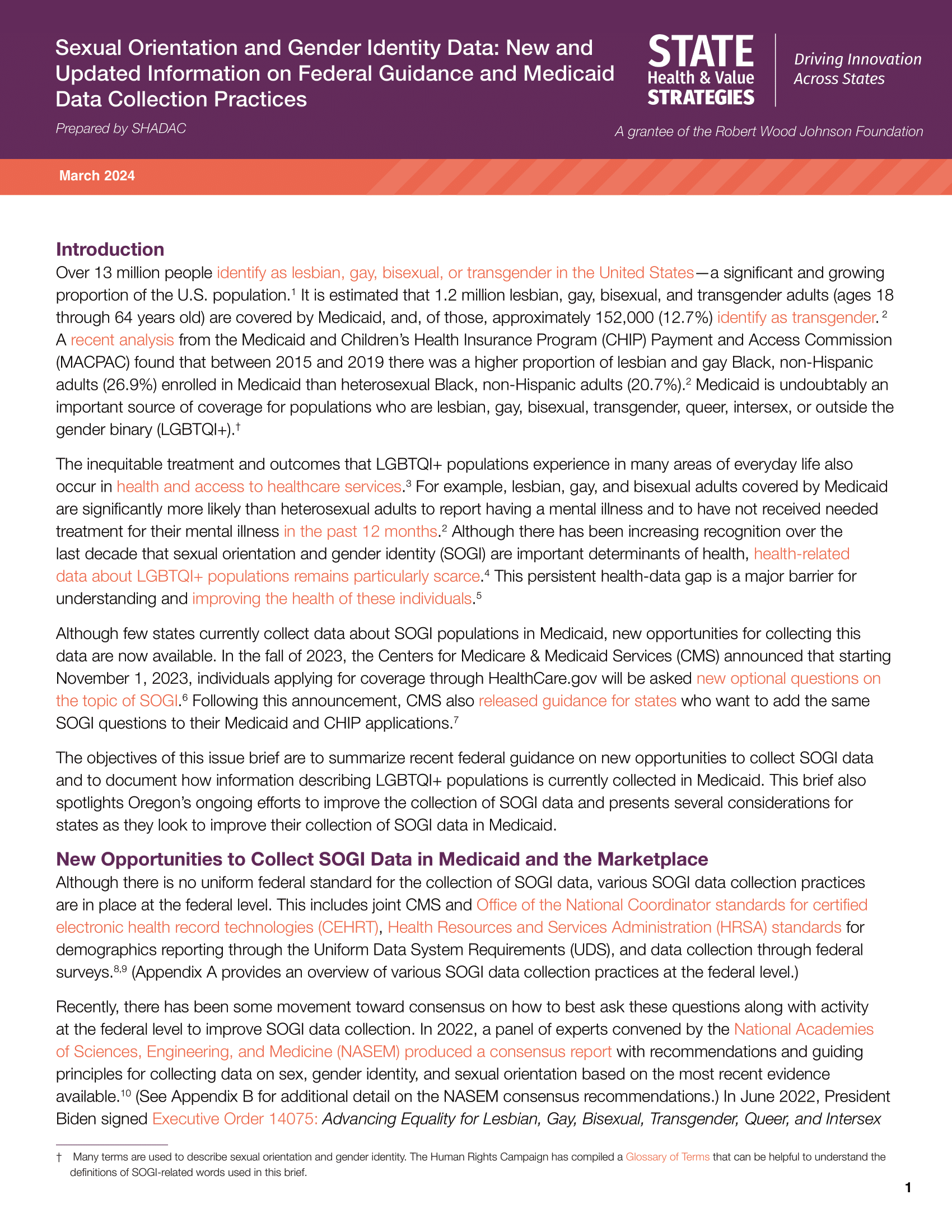Blog & News
Print
LGBT Health Equity: Sexual Orientation and Gender Identity Data Resources and Information from SHADAC
October 28, 2024:June of each year is known as “Pride Month” – a month to celebrate the diversity and achievements of the over 13 million Americans that identify as lesbian, gay, bisexual, transgender, or queer/questioning (LGBTQ).
Alongside celebration, this month is also a time for people to learn about the inequities that many LGBTQ+ people face. Studies have shown that LGBTQ+ people face higher levels of discrimination in a variety of sectors including health care, housing, and employment. Looking a bit closer at the disparities LGBTQ+ people face in health care, studies have found that compared to non-LGBTQ+ people, LGBTQ+ people are:
- Less likely to have health insurance coverage
- Less likely to have a regular health care provider
- More likely to delay care
- More likely to report poor quality care and unfair treatment from providers
The causes of these inequities are complex and intersectional in nature. Understanding the causes of these disparities (and the potential solutions for improving health equity) begins with understanding the populations themselves.
SHADAC works to understand communities, populations, identities, and the factors that impact them through data collection, data disaggregation, and a core focus on health equity in all of our work. In this post, we will provide an overview of some of the products and resources we have published in the sexual orientation and gender identity space, including publications on Sexual Orientation and Gender Identity (SOGI) data collection, LGBT health, gender discrimination in health care, and more.
Sexual Orientation and Gender Identity Data: New and Updated Information on Federal Guidance and Medicaid Data Collection Practices (SHVS Brief)
Federal SOGI data collection efforts are evolving – in 2021, SHADAC researchers authored a State Health and Value Strategies brief examining the few examples of SOGI data collection efforts occurring at the federal level and in Medicaid.
SHADAC continued to monitor efforts and guidelines in SOGI demographic data collection at both the state and federal levels to stay as informed and up to date as possible. In the fall of 2023, new SOGI data collection guidelines were announced by Centers for Medicare & Medicaid Services (CMS) alongside guidance for states to add SOGI data to state Medicaid applications. This resulted in the authors updating the previous brief and adding additional information on the new federal guidance and emerging recommended best practices.
Read the full updated brief here that includes a summary of the current landscape of SOGI data collection in Medicaid in all 50 states, a spotlight on Oregon’s SOGI efforts, and a discussion of considerations for states wanting to implement these new SOGI questions into their Medicaid application(s).
State Health Compare: Explore Health Data with SOGI Data Breakdowns
State Health Compare is SHADAC’s interactive data visualization tool that allows users to explore state-level health data on a wide variety of measures. This tool is created using data from a number of sources, including survey data.
One survey that SHADAC utilizes is the Behavioral Risk Factor Surveillance System (BRFSS) – this survey collects data from U.S. residents on health-related risk behaviors, chronic health conditions, and use of preventive services.
As one of the tool’s newest updates, State Health Compare users can now view select BRFSS data measures by sexual orientation. Data disaggregation such as this can help inform health equity work, revealing trends, gaps, and differences that may not have been obvious or visible looking at the overall data.
The following measures have now been updated to explore by sexual orientation:
- Adults Who Forgo Needed Medical Care Due to Cost
- Adult Smoking
- Adult Excessive Alcohol Consumption
- Adult E-Cigarette Use
- Chronic Disease Prevalence
- Adult Unhealthy Days
- Activities Limited Due to Health Difficulty
- Adults with No Personal Doctor
- Adult Cancer Screenings
- Adult Flu Vaccinations
See an example of what you can do with this data below, where we breakdown the measure 'Percent of Adults with No Personal Doctor' by Sexual Orientation.
SHADAC hopes to expand SHC’s list of measures by sexual orientation (and eventually by gender identity) to allow for better understanding of where gaps and health disparities exist for individuals in the LGBTQ+ community.
Find the measures we have updated with sexual orientation information by clicking the links in the bulleted list above. You can also explore all of our available measures here.
Gender Based Discrimination in Health Care by Gender Identity in Minnesota
In 2022, SHADAC researchers wrote a blog analyzing data from the Minnesota Health Access Survey (MNHA) where respondents were asked how often their gender, sexual orientation, gender identity, or gender expression caused health care providers to treat them unfairly.
SHADAC researchers found that the majority (58.9%) of transgender and non-binary respondents reported experiencing gender-based discrimination from health care providers compared to the statewide average of only 6% reporting gender-based discrimination.
Beyond discrimination, researchers also found differences in health care access between populations in Minnesota, including that:
- Over half (57.1%) of trans and non-binary people reported forgone care—more than double the overall average of 26.2%
- Nearly one-third of trans and non-binary adults had low confidence in getting necessary health care—compared to the overall average of 11.8%
Examining Discrimination and Health Care Access by Sexual Orientation in Minnesota
Created as a companion piece to the ‘Gender-Based Discrimination’ blog just described, this blog also uses data from the MNHA Survey to understand disparities and differences in how individuals of different sexual orientations experience discrimination and/or effects on health care access.
When compared to the state average and/or to straight individuals:
- Both lesbian/gay and bisexual/pansexual people were more likely to report barriers to health care access
- Bisexual/pansexual people were more likely to report having low confidence in the ability to get needed health care
- Both lesbian/gay or bisexual/pansexual people had significantly higher rates of forgone care
Read more about the other findings and our researchers’ analysis of them in the full SOGI Discrimination blog here.
SHADAC Response to 2023 Request for Comments on American Community Survey SOGI Questions
In the fall of 2023, the U.S. Census Bureau released a request for comments regarding the proposed addition of test SOGI questions for the American Community Survey (ACS). While SHADAC was encouraged by the effort to improve SOGI data collection by including questions on a large federal survey, our researchers had a number of comments and proposed adjustments regarding question wording, response categories, and placement within the survey.
Stay Up to Date on the Latest in SOGI and LGBT Health Data
The resources and products above represent just a portion of the work SHADAC is doing to help advance health equity. It’s our hope that accessible data and the findings that come from it can shed light on the experiences of various populations, helping us identify gaps and disparities that can be addressed and changed to advance health equity.
Stay up to date on our latest releases and updates by following us on LinkedIn, or by signing up for our newsletter.
Continue your journey to understand health disparities and health equity with the following products:











